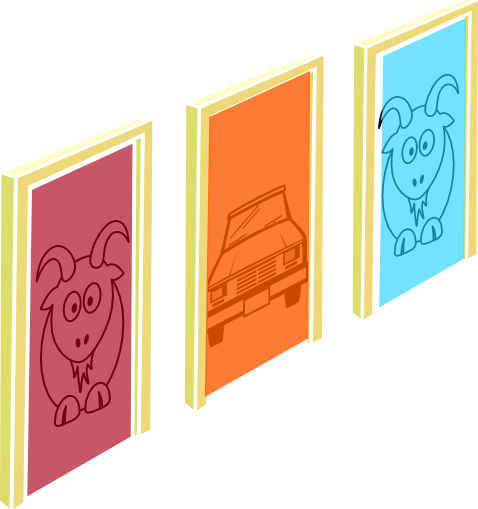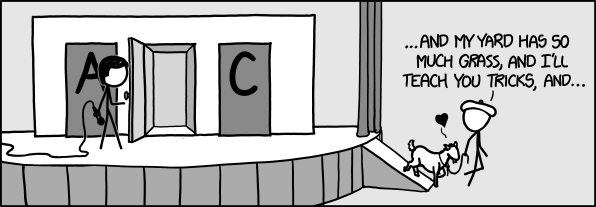| The Monty Hall Problem |
| Written by Mike James | |||
| Thursday, 09 April 2020 | |||
Page 1 of 2 The Monty Hall problem is an exercise in probability theory that even experts get wrong. It seems to be subtle and even paradoxical, but when you notice exactly what is going on it becomes obvious. Read this article and I guarantee you will understand the Monty Hall problem and recognize when it occurs in other settings.
Setting the sceneAlthough it gained fame as part of a game show "Let's Make A Deal" hosted by Monty Hall, hence its name, the problem was first raised by Steve Selvin in American Statistician in 1975. It is also associated with the columnist Marilyn vos Savant after she answered a question about it. The problem is easy to state: You are given the choice of three doors. Behind one door is a car and behind the others there are goats. You are asked to pick a door. The host knows what is behind each door and opens a door, at random if there is a choice, to show you a goat. The question is do you want to change your choice of door to the other remaining door?
The reason why this is confusing is that common sense says that when you pick a door you have a 1 in 3 chance of picking the car. After the host shows you that there is a goat behind one of the other doors, you still have a 1 in 3 chance that you picked the car. Why change - the other door also had a 1 in 3 chance of having the car behind it? Even if you notice that now there are only two doors, each door has a 1 in 2 chance of having the car behind it, i.e. they are equally likely. What possible point can there be in swapping your choice to the other door? The two remaining doors seem the same and no information about where the car is seems to have been passed to the player by the host. . However, the indisputable fact is that if you switch you have a 2/3 chance of wining the car and if you stick with your choice you really do only have a 1/3 chance of wining. This seems paradoxical. If it is true where is the extra information coming from that improves your winning probability when you switch? The host didn't appear to give you any information about where the car is or anything related to your choice of door. So where is the information coming from that improves your chances if you switch? There is no point in arguing that this whole thing is silly and sticking with your original choice is just as good as swapping. It doesn't take long to write a program that simulates the two strategies and it takes even less time to demonstrate that the data converges quite quickly to a win probability of 2/3 for swapping and 1/3 for not swapping. It is in this sense that I stated that the "swap is better rule" is an indisputable fact. So how can you understand this almost paradox? One way, and it is a common approach in both math and programming, is to generalize the problem and then take it to an extreme. Monty Hall(n,m)In the case of the Monty Hall problem we can generalize the set up to have n doors and allow m doors to be opened after the initial choice. This is the Monty Hall MH(n,m) problem. Now consider the MH(n,n-2) case, i.e. open all but the chosen door and one other presenting the player with a simple swap option. To see how the standard MH(3,1) actually works we need to consider something like the MH(100,98) puzzle works because in this case what is going on becomes very clear. MH(100,98) involves 100 doors with 99 goats and one car behind them. The player pick one door and then the host opens 98 doors to reveal 98 goats. Now the player is faced with two doors - the one initially picked and the one left after the grand opening. The door that the player initially picked had probability of 1/100 of having a car behind which means the there is a 99/100 chance that the car is actually behind one of the doors not picked. Notice that there is a much much bigger chance that the car is behind one of the remaining doors. In fact, as you make n bigger the chance that the car is behind the remaining doors in the MH(n,n-2) problem goes to one, i.e. a certainty. Next the 98 doors are opened to reveal goats and a single door remains unopen. Given the probability that the car was behind one of the set of doors that could have been opened is 99/100, you now have two choices - to stick with the door you picked when the probability was 1/100 or to swap to the door that has a probability of 99/100 of having a car behind it. No contest - you swap to the almost certain win. Unless of course you really do want the goat.
More cartoon fun at xkcd a webcomic of romance,sarcasm, math, and language
Where the car ISSo where did the extra information come from? When you picked a door at random the probability that it was in the set of doors that you didn't pick was 99/100, i.e. it was almost certainly in the set you didn't pick. The host then shows you which of the 98 doors the car isn't behind. To do this the host has to know where the car is and this is the information communicated to the player by the door that isn't opened. Of course, if the player has picked the car then the host doesn't pass any information to the player, but this only happens one in a hundred times on average. But most of the time, i.e. 99 times in 100, the host tells the player where the car is. After you have seen the explanation, it can be difficult to see how other people don't "get it" and even how you didn't "get it". Imagine that another person walks in after the host has opened the 98 doors to reveal the 98 goats. As long as they don't know which door the player selected, and hence which door the host left closed, then they should pick either door with a probability 0.5. Without the information as to which door was selected and which was left closed there is no reason to prefer either door. This highlights the importance of the information provided by the host. If you know which door was picked and which was left closed then the probabilities you assign to the doors isn't the same.
|
|||
| Last Updated ( Thursday, 09 April 2020 ) |

